Calterah Chips with RoP® Enable More Powerful and Affordable Radar for Automotive Active Safety and ADAS new
As intelligent driving assistance gets widely applied, automotive radar sensors are required to be more powerful and affordable. This trend gives rise to a series of technological innovations, among which waveguide antennas are becoming more extensively used. Compared with traditional radar solutions, radar with waveguide antennas boasts outstanding improvements in performance and cost efficiency. With forward-looking technological strategies, Calterah has launched the innovative Radiator-on-Package (RoP®) technology and taken the lead in having mass-produced mmWave radar SoCs with RoP®.
What is RoP® Technology?

RoP® stands for Radiator on Package, Calterah’s most leading-edge and innovative packaging technology for mmWave radar chips. Radiators, integrated in the package of a System-on-Chip (SoC) device, are used to radiate RF signals.
Traditional packaging technologies use BGA solder balls to transmit RF signals, which are transformed into the microstrip mode and sent to microstrip antennas via microstrip lines. Calterah’s RoP® employs radiators to directly transmit signals to a waveguide antenna system after passing through the PCB, achieving more efficient signal transmission and better performance.
Calterah RoP® technology can boost the competitiveness of radar modules in performance, cost, flexibility, and many other dimensions. To date, Calterah has filed around 40 patent applications for the RoP® technology.
Calterah RoP® with Multiple Advantages in Performances, Costs, etc.
- Superior Cost Efficiency
Radar modules enabled by Calterah RoP® chips do not need expensive high-frequency PCB boards and feedline shielding covers, fundamentally reducing material and manufacturing costs. This creates the possibility for waveguide antenna module costs to fall below those of PCB antenna modules.
- Excellent Performance Brought by Reduced Feedline Loss
Radar modules with Calterah RoP® chips employ air waveguides to transmit RF signals. The feedline loss of air waveguides is typically below 0.1 dB/cm, while a radar module with PCB antennas has a 0.6-0.8 dB/cm loss caused by feedlines on high-frequency boards. This means radar modules with Calterah RoP® chips have a 0.5-0.7 dB/cm loss reduction. Moreover, the enclosed air waveguide structure effectively mitigates radiation issues caused by discontinuities of microstrip feedlines for PCB antennas.
- Flexible Antenna Designs for Complex Scenarios
Calterah RoP® technology supports multiple waveguide antenna architectures, including the architectures of dual-layer antennas, 1.5-layer antennas, and single-layer antennas. It also supports the integration of antennas and radomes. So far, Calterah RoP® has achieved the antenna thickness of as low as 2 mm. Compared to planar PCB antennas, 3D waveguide antennas offer greater design flexibility, overcoming the challenges faced by PCB antennas, such as low channel amplitude consistency and phase center deviation.

Transmission Structures of Different Antenna Architectures
- Highly-Efficient Heat Dissipation Unleashing Package Potential
Calterah SoCs with RoP® achieve enhanced thermal management through direct contact with metallic heat sinks. This approach ensures more effective temperature control, compared to traditional thermal dissipation methods dependent on PCB, while providing more flexibility for solder ball arrangement.
- Outstanding Mass Production Capability with High Reliability
The ridge waveguide interface used by Calterah RoP® is 17% smaller in area compared to traditional rectangular waveguides, with cutoff frequencies below 70 GHz. This structure combines excellent manufacturability with exceptional robustness, effectively resolving the trade-off between reliability and production efficiency.
Boasting advantages of high performance, low costs, high flexibility, and high reliability, Calterah RoP® technology enables better solutions for mmWave radar modules, ideal for intelligent driving assistance and sensing applications.
Calterah RoP® Taking Radar Detection Performances to the Next Level
Traditional PCB antennas use high-frequency materials as a medium, resulting in extra medium loss in the transmission of RF signals, which significantly affects radar performance in the mmWave frequency band. Calterah SoCs with RoP®, working with waveguide antenna systems, allow signals to be transmitted in metal cavities with almost no medium loss, achieving higher signal transmission efficiency.
In the comparison of solutions based on Calterah Alps-Pro SoC with standard package (working with PCB antenna) and Calterah Alps-Pro SoC with RoP® (working with waveguide antennas), the radiation pattern of waveguide antennas is similar to that of PCB antenna. Yet notably, the TRX gain improvement brought by Calterah RoP® technology is up to 6.4 dB, which exerts decisive influence on long-range target detection and intelligent driving-assistance scenarios.
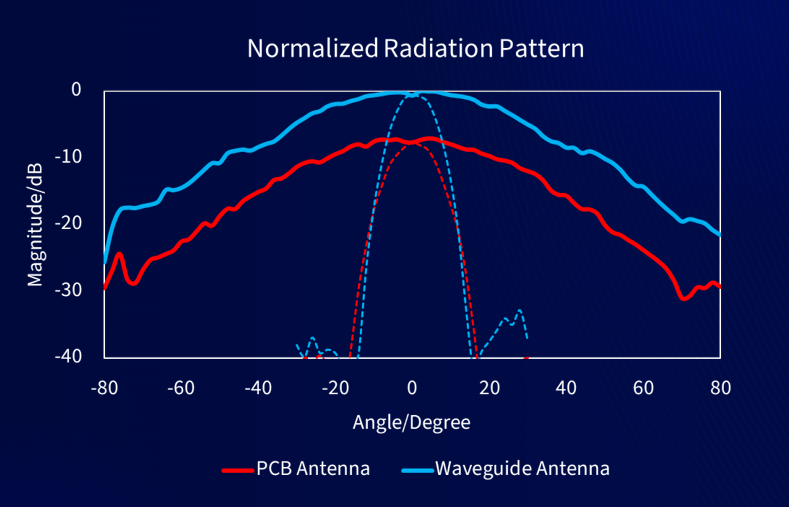
Improved TRX Gain of Waveguide Antenna System
After comparing testing results of a radar module based on a Calterah RoP® SoC (RoP® module) and a radar module based on a standard Calterah SoC (standard PCB module), it can be found that the RoP® module boasts remarkable advantages in core performance benchmarks:
- Human Detection Range (±60° FOV): Up to 50% increase
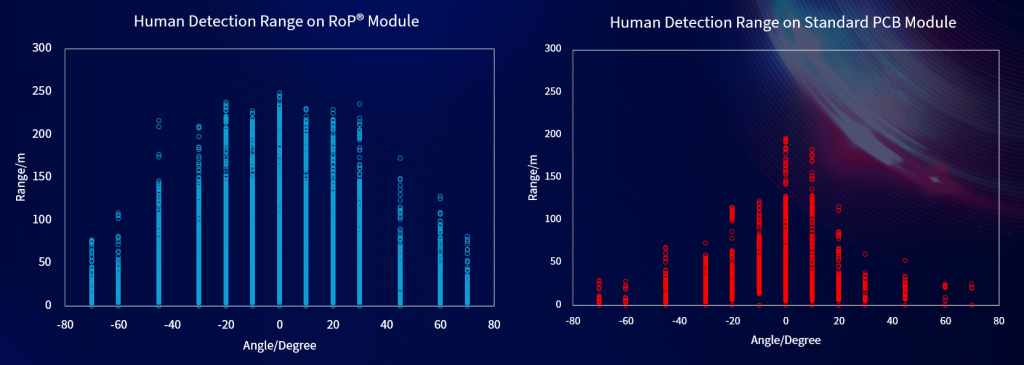
Improved Radar Detection Range
- Angular Accuracy: Up to around 20% increase
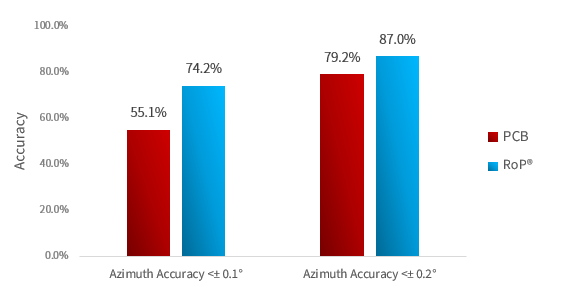
Angular Accuracy Comparison of RoP® Module and Standard PCB Module*
* Based on Statistical Results within Entire Two-Dimensional FOV Plane
- Angular Resolution Accuracy: 2%–6% increase
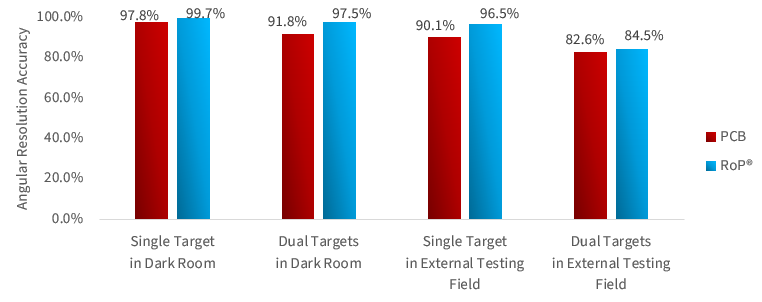
Comparison of Angular Resolution Accuracy (RoP® Module vs Standard PCB Module)
These performance improvements enable more stable target recognition, more accurate target separation, and more reliable environmental sensing capability. With higher gains and stronger performance, Calterah SoCs with RoP® are becoming the go-to solution of next-generation intelligent driver-assistance systems.
Calterah Alps-Pro RoP® and Andes RoP® SoCs Empowering Active Safety of ADAS
As intelligent vehicles evolve, 3 or 5 mmWave radars per car have become the standard configuration. mmWave radars are required to have higher performances to meet the needs of safer and more intelligent driving-assistance functions. Compared to chips with standard package, Calterah’s Alps-Pro family of radar SoCs (CAL77S344-AR) and Andes family of radar SoCs (CAL77C644-AR and CAL77C844-AR) with RoP®, enable longer detection range, wider FOV, and stronger angular resolution capability.
- Calterah Alps-Pro SoCs with RoP® (CAL77S344-AR), working with waveguide antenna systems, enable ADAS applications such as automotive corner radar and forward-looking radar, helping vehicles achieve safer and more reliable functions such as blind spot detection (BSD), lane change assist (LCA), rear cross traffic alert (RCTA), forward collision warning (FCW), etc. As a mass-produced product, Calterah Alps-Pro SoC with RoP® has continuously won car model awards of mainstream OEMs in both China and abroad, empowering the intelligent driving-assistance systems of more vehicles.
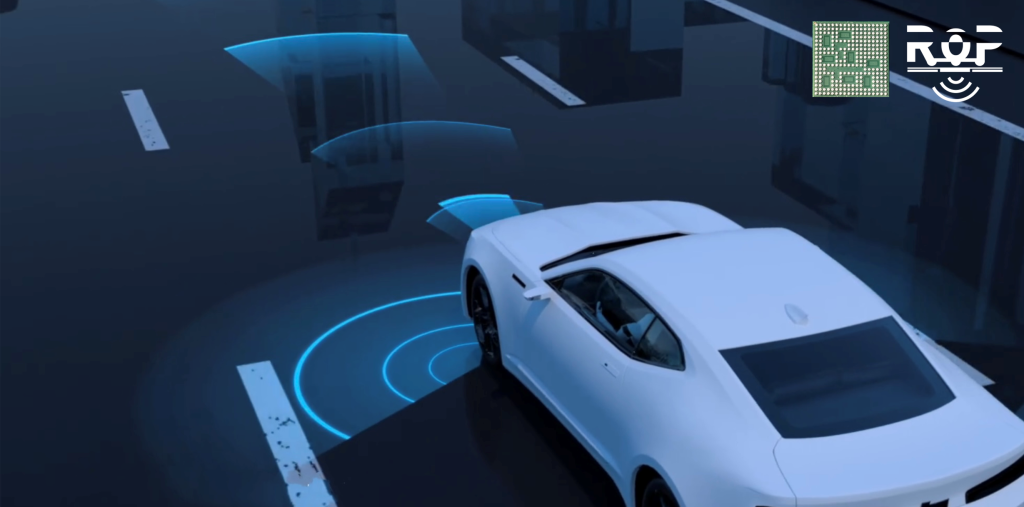
- Based on the Andes SoC with RoP® (CAL77C844-AR), Calterah has launched the premium imaging radar solution with two cascading chips. Working with the waveguide antenna system, Calterah’s premium imaging radar solution supports more accurate 4D measurement, more stable detection of weak targets, and imaging with richer point clouds. By accurately depicting vehicles and vulnerable road users (VRUs) on complex urban roads, such as three-wheelers, two-wheelers and pedestrians, the solution can ensure safety for autonomous driving of L3 and higher levels.

As the intelligent transformation of automotive industry accelerates, Calterah has been evolving its technologies in wireless semiconductors and advanced packaging, via incessant disruptive and continuous innovations. By providing customers with more competitive and reliable radar SoCs and solutions, Calterah will continue facilitating safer, smarter driving-assistance experiences.
